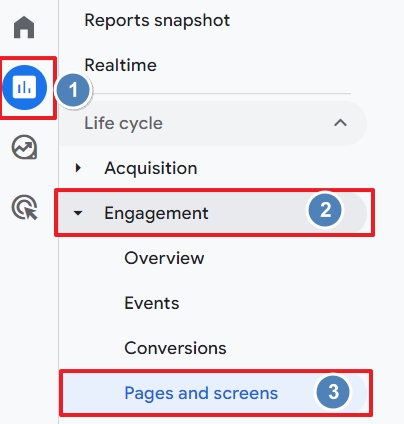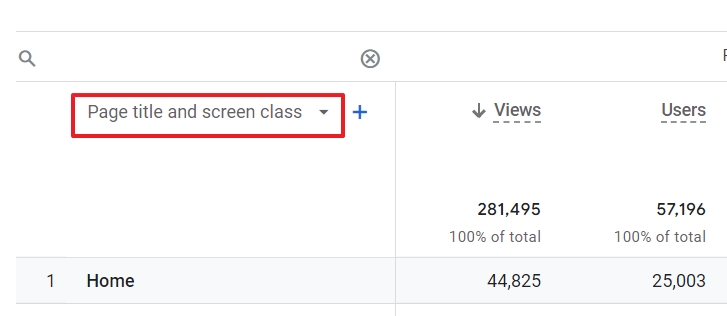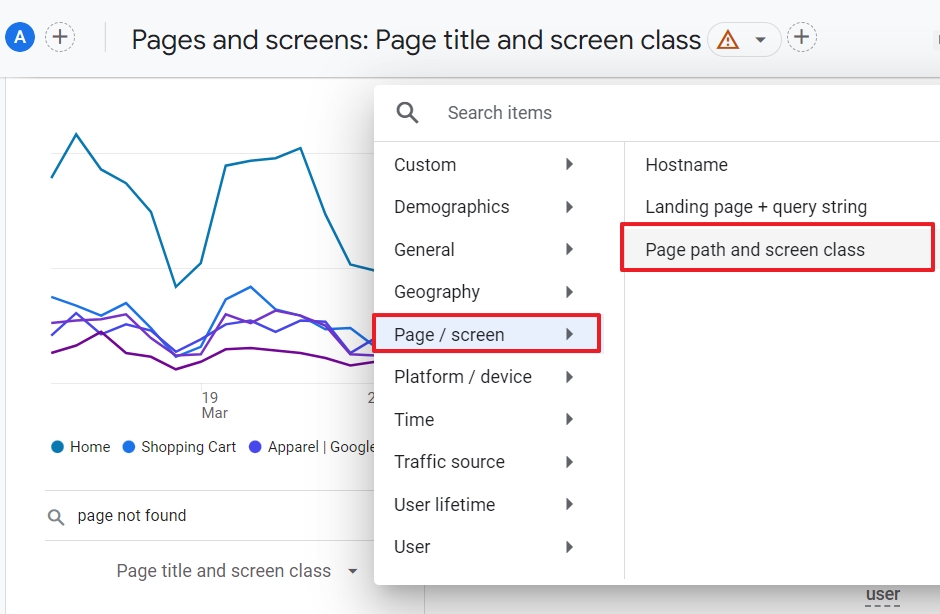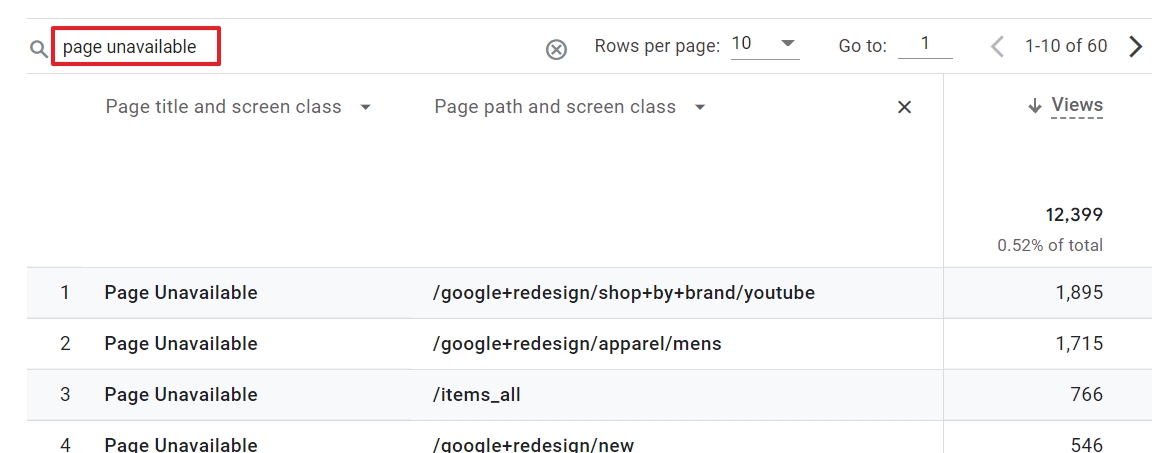In Google Analytics 4, you can easily find data about 404 pages. If you want an in-depth analysis of the most famous error on the Internet, you have to create an exploration report. Yet, not all 404 errors deserve your attention because not everything that’s not found is actually lost…
Key takeaways
- A visit to a non-existing web page results in a 404 server error.
- A 404 page informs visitors about the error and can help them find the content they were expecting to find.
- In GA4, you can look up data about 404 pages with a custom exploration report.
- Fixing 404 errors is a Sisyphean task. Understanding the causes is important to focus on the main issues
- There are 3 solutions to fix 404 errors.
- GA4 doesn't help you to prevent these mistakes.
What is a 404 error, anyway?
A 404 error is a server error that happens when a visitor lands on a web page that doesn’t exist. To inform users that the error occurred, you can set up a 404 page.
The alternative is to redirect visitors automatically to the home page. This is the easiest way and (therefore) not ideal to boost the engagement rate of visitors.
Imagine you reserved the bridal suite. After unlocking the door, you find yourself back in the hotel lobby. That’s the real-life equivalent of redirecting users to your home page instead of showing them a 404 page, like the one from Google.

If your site has a dedicated 404 page, look for the page title.
That’s all you need to find instances of the not found error event in GA4.
Please mind, the title is not a fixed value. On your site, it can be something else:
- Page not found
- Page unavailable
- Oops. Error 404 occurred
- …
It is also important that this page title is unique and not used on other (error) pages.
If your site doesn’t have such a page, talk with your developers. They can track the error with Google Tag Manager and send it to GA4. Good luck with squeezing that task into the roadmap.

How to find 404 pages in GA4?
If you know the page title of your 404 error page, it only takes 4 steps to find not found pages in Google Analytics 4.
Step 1: Open the Pages and Screen report

In GA4, go to Reports > Engagement > Pages and Screen
Step 2: Select Page Title and Screen Class as dimension

You can change the primary dimension of reports. For the 404 page, make sure you select Page Title and Screen Class as the primary dimension.
Step 3: Select Page Path and Screen Class as secondary dimension

Click on the + icon next to the primary dimension and go to Page/screen > Page path and screen class.
Step 4: Search for the title of your 404 page

Type the title of your 404 page in the search box and hit enter.
This method is straightforward and easy, but…
- it only gives you a list of pages that don’t exist but users tried to visit.
- imagine you had to do this every day/week/month. I can only talk for myself, but in this case, consider ME not found in the office.
A more robust and useful solution is to set up an exploration from a template.
How to monitor 404 pages in GA4?
An exploration report is your best option in GA4 to analyze and monitor 404 pages. To build this from scratch, follow the steps below.
Step 1: Create a new exploration

Click on Explore in the left menu and then on Create a new exploration.
Choose the Blank template.
Step 2: Give your exploration a name

You can, e.g., call it: 404 report.
Step 3: Click on the + sign to add dimensions

Since the report is blank, we need to add dimensions to it.
Step 4: Add dimensions

In the Predefined tab, scroll to Page / Screen and select these 3 dimensions:
- Page path/screen class
- Page referrer
- Page title
Also, scroll to Event and select Event name.
Then click the blue Import button to add the dimensions to your exploration.
Step 5: Create the rows

Drag the following two dimensions to the Rows box in the Tab settings panel.
- Page Path and screen class: the part of the URL that doesn’t exist.
- Page referrer: where was the error triggered? This can be an external domain, or a URL of your site.
Step 6: Add filters to the exploration

Drag the following two dimensions to the Filter box in the Tab settings panel:
- Event name
- Page title
Step 7: Configure the filters

- For the Page title filter, use the values of your 404 page. This can be, e.g., Page not found, page not available, Error 404…
- For the Event filter, use “exact match” and “page_view”, since we only need these events in the exploration.
Click Apply under both filters.
Step 8: Add the Event Count Metric

A metric is all that’s missing now to populate your 404 report.
Click on the plus sign of the Metrics field in the Variables panel
Step 9: Import the metric to the exploration

Select Event count under Events and click on the blue Import button.
Step 10: Drag the metric to values box

Drag Event count from the Metrics box in the Variable panel to the Value box in the Tab settings panel.
Now your exploration shows data. If you see nothing, this can indicate that:
- you did something wrong
- nobody landed on a page that doesn’t exist for the select date range
Your 404 exploration is ready and in the future, you can access it under the templates of Explorations.
Tracking, finding and monitoring pages with 404 errors in GA4 is not super complicated. The harder part is to pinpoint and prioritize the issues. And that can be a bit more challenging…
It’s time to put on your holistic goggles.

How to use the 404 error report in GA4?
To fix 404 errors in the best possible way, you need to understand what caused it. There are 3 reasons, but you only have full control over one of them.
Let’s start with the errors you can solve. In the next paragraph, I will explain how.
Internal broken links
Internal links refer to a page of your own domain(s). When the URL of the link doesn’t exist, the link is broken and the error 404 is triggered on the server.
The GA4 exploration gives you a first clue on which pages you can find these links. You can add a filter Link domain and select your domain only.

If you find issues, visit the page and check all the links on it to find the one that is broken.
Pro tip: You can use browser extensions, plugins and even online broken link detectors to find potential issues in no time. Some solutions monitor your site proactively and warn you when a link is broken.
GA4 only logs these errors when they occur. That is a less powerful approach than preventing.
Google Search Console does the same, but it sends you a mail when it happens. This is one more good reason to use both GSC and GA4.

External inbound broken links
External links are from other domains. Unless you own or can control them, you cannot fix these broken links yourself.
A special type of external links are those in your emails, pdf files, etc. In GA4, you can track these with UTM tags.
Depending on the traffic source, or the site the link to your page resides, the impact can be from:
- Meh, so what? For instance, a link from a low authority domain won’t generate a lot of traffic or boost your SEO.
- OMG. Links from search engines, for instance, to pages that don’t exist are pure horror. The same for links on social media that would normally drive tons of traffic to your page.
User errors in URL
Users type in URLs and that can cause 404 errors. Especially on smartphones, it’s easy to make mistakes. That's one reason why QR codes can be a marketer's best friend.
Don’t worry about these errors, but you can still try to prevent them with some good URL practices:
- Do NoT MiX CaPiTaLiZaTiOn in your URLs
- Stick to hyphens instead of underscores
In GA4, these errors usually don’t have a page referrer.
How to fix error 404?
There are 3 ways to fix error 404s. The best solution depends on the size of your site but also on what causes the error.
Remove the link
This is an easy way, but not always the best one.
- You need to be able to remove the link. If you don’t own the medium that contains the link, you will depend on the goodwill of others to do it.
- A button without a link causes user frustration.
- Internal links contribute to SEO (Search Engine Optimization). Removing them can impact the ranking of other pages.
Change the link
This is the best option if
- The URL contains a typo (E.g.: www.yourcoolandgreatwebsite.com/contakt)
- The target page no longer exists. In that case, you can best look for a page that is closely related to the original one. Changing the anchor text of the link can be useful too.
- You don’t have a big website with many pages.
- Or the error doesn’t occur on many pages, but it is still worth fixing it. For instance landing pages of paid campaigns are best broken link free. It’s a detail but it helps achieve the highest possible ROI. Other tips are listed in our free GA campaign tracking checklist.
- You can change the link. Again, if somebody on, for instance, social media links to a webpage of you with a wrong URL, you depend on others to fix that error.
Redirect the page to another page
Instead of going through all your pages and links, you can also redirect a page to another one. This is called a 301 redirect, which is useful if:
- The target page was removed permanently.
- You have a big site and many links pointing to the page that no longer exists.
- The original page was ranking in search engine results. If you set up a 301 redirect, Google and others will pick up the changed address automatically. Users will also land on the redirected page.
Damage control
Despite all your efforts, 404 errors cannot be avoided. The best you can do for your visitors and yourself is:
- Use a dedicated 404 page (instead of using default ones or redirecting to the home page).

- Show a message that explains to your users that the page is not found, doesn’t exist, is not available.
- Give them an easy option to find the content they were looking for. You can include the main sections of your site, a sitemap or even better, a search box.
Useful FAQ
Does GA4 track 404 errors on other sites?
Although error 404 on websites you link to is a bad user experience, you can’t see in your GA4 account if those links are broken.
You can automatically track clicks to external domains with enhanced measurement, but this won’t help you detect 404 errors on those sites either.
Yet, it is worth it to check them regularly and, if needed, fix the links. Why?
You can best compare it with recommending a restaurant that’s no longer in business to a friend.
Final note on 404 and GA4
GA4 is only one tool to find and monitor 404 pages and errors.
Although there are far more reliable tools to track not found pages errors, it’s still worth it to set up this exploration in GA4.
- Not everybody from your team has access to all your website monitoring tools. By creating the report in GA4, you have an additional free monitoring tool.
- You can add other dimensions to the error 404 exploration. This allows you to focus on broken links that hurt you most, or keep track of 404 errors over time.
Together with the rest of the DDU team, I am delighted you found this page. I also hope you found it useful to find not found pages in GA4. I will see myself out now…
